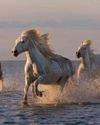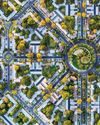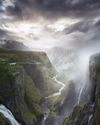Over a 30-year career in imaging science, Shree Nayar has already transformed the camera in your pocket. Now he’s out to unlock images you’ve never seen before.

Standing in front of a projection screen in his office at Columbia University’s School of Engineering and Applied Science, Shree Nayar points to a close-up of a human eye. At first glance, it’s nothing remarkable: just a healthy brownish color with striations zigzagging between the edge of the iris and the pupil. But the cornea of the eye, Nayar explains, has a thin film of tear on it that makes it a reflective surface, a mirror. Straight on, that mirror is a circle; at an angle, it’s an ellipse; but it’s always a mirror.
Nayar clicks to the next slide, an inside-out image of that same eye. “You can go back to the picture and figure out exactly what’s falling on the full mirror, which is a wide-angle view of the world around the person.” The subject’s surroundings are apparent in the image, but algorithms developed by Nayar’s lab can isolate the specific thing the person is focusing on. This research, first published in 2004, is only one example of how Nayar believes we can develop new photographic technologies that will reveal our world in ways we’ve never seen before.
Nayar, 53, heads the Columbia Vision Laboratory, where he has been a pioneer in the discipline of computational imaging, or computational photography. Conventional digital photography largely emulates the structure of the original camera obscura, which uses lenses to deliver and replicate a 3-D image on a 2-D plane. Computational imaging uses digital processes and novel optics to capture light in ways that would be garbled or unrecognizable to our eyes. Following capture, it’s the sensor or image processor’s job to unscramble the data to reveal a final image. The approach opens up features and functions that would not be possible using traditional photography.
この記事は Popular Photography の January 2017 版に掲載されています。
7 日間の Magzter GOLD 無料トライアルを開始して、何千もの厳選されたプレミアム ストーリー、9,000 以上の雑誌や新聞にアクセスしてください。
すでに購読者です ? サインイン
この記事は Popular Photography の January 2017 版に掲載されています。
7 日間の Magzter GOLD 無料トライアルを開始して、何千もの厳選されたプレミアム ストーリー、9,000 以上の雑誌や新聞にアクセスしてください。
すでに購読者です? サインイン

Tips for Taking Majestic Horse Photographs
Carol Walker is one of the world’s preeminent equine photographers. Whether stallions, mares, mustangs, or geldings, she captures them in all their natural splendor. Here, she shares her secrets for making images of horses in the great outdoors.

Finding Structure In A Jumbled World
Whether shooting from above, below, or on the ground, Jeffrey Milstein finds structure in our jumbled world.

A Star's Turn
In a year of bravura performances, the Fujifilm X-Pro2 claimed the spotlight early and earned a standing ovation.

aloha adventure
sizzling lava, hidden waterfalls, dramatic waves... unimaginable beauty awaits in hawaii. four photographers divulge their best secrets for capturing the islands’ majestic landscapes.

freeze frame
use hot-shoe flash units to stop motion.

road trip
take a drive through a living heritage.

Double Take
Adding mirrors can multiply your portrait lighting challenges.

Concrete Thoughts
Conversation, inspiration, contests, and your questions answered.

Main Squeeze
When life hands you lemons…

A Winning Year
Exploring the woods of Canada with a snow-dusted fox, watching the stars from under a cave on the Northern California coast, cheering front row at an action packed Arizona rodeo, or unearthing the inner workings of a family heirloom, this year’s prize winners captured mementos of lives well lived—and well photographed. Read on to find out the creative ways our readers used their cameras to skillfully depict their worlds.